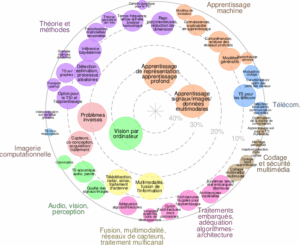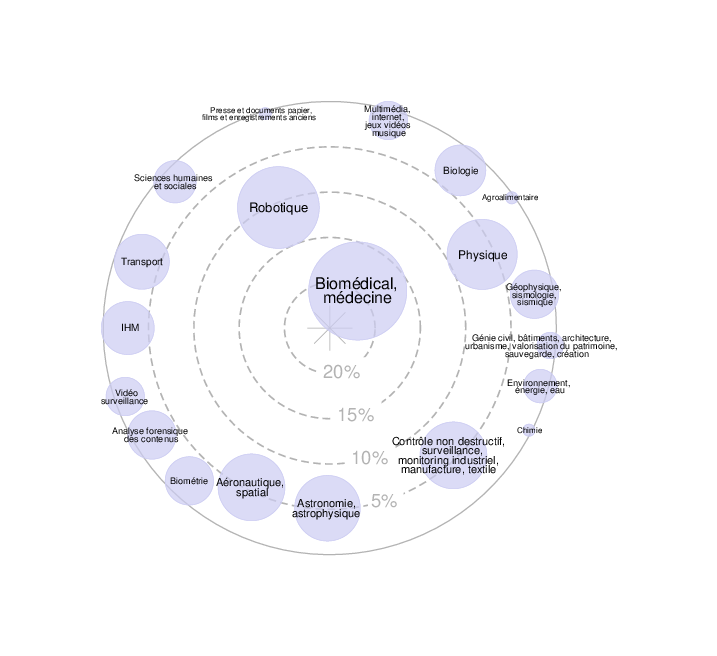Context
In a context of continuous and growing digitalization of human activities, information security has become a critical concern aimed at maintaining control over our digital infrastructures. It takes on three specific forms—confidentiality, integrity, and availability—and applies to all electronic systems within networks, from the physical layer to the application layer of the OSI model.
During this PhD work, we will mainly focus on information availability at the physical layer. In this context, the concept of availability refers to the system’s ability to transfer information from point A to point B using a transmission medium. This medium can be an optical fiber in the case of wired communication, or the surrounding environment in the case of wireless communication. The latter will be the focus of this thesis, as the radio spectrum is easily and inexpensively accessible to malicious users, who often need only basic programming skills to intentionally interfere with civilian or military systems. In addition, wireless communication is the only viable means of transmitting information in scenarios involving high-speed mobility or low infrastructure density. As a result, these systems require special attention in terms of security to ensure service continuity.
Objectives
Historically, the challenge of securing information availability has been addressed using statistical signal processing tools such as the Wiener and Kalman filters [1] [2]. This PhD work will focus on developing joint methods that combine statistical signal processing and machine learning, tailored to securing the physical layer at the receiver side in the context of SISO communications [3]. In particular, we will investigate how to enhance the security of Direct Sequence Spread Spectrum (DS-SS) and Frequency Hopping Spread Spectrum (FH-SS) signals, which are inherently robust against intentional interference [4].
The objectives of this PhD can be structured around the following complementary research axes :
- Compressed Sensing and Sparse Reconstruction [5][6]: Assess the receiver’s ability to reconstruct interference from partial knowledge of the received signal, with the aim of canceling the interference based on this estimation.
- Model-Based Deep Learning: Explore the potential of joint approaches that combine statistical signal processing and machine learning to reconstruct and suppress interference from the received signal.
- Software-Defined Radio (SDR): Validate simulation results through experiments over real propagation channels using the software-defined radio platforms available in the laboratory.
Methodology
Aside from the final writing phase (4 months), the PhD thesis will be structured into four main stages:
- (4 to 6 months) – Literature Review: An in-depth review of the literature will be conducted to establish the state of the art regarding intentional interference and the associated mitigation algorithms.
- (9 to 12 months) – Interference Reconstruction: The objective of this phase will be to implement a strategy for reconstructing identified intentional interference from observations of interfered DS-SS and FH-SS signals.
- (6 to 8 months) – Model-Based Deep Learning Design: This phase will focus on designing a model-based deep learning network, whose architecture will be structured according to the reconstruction strategy developed in the second phase.
- (4 to 6 months) – Experimental Evaluation on SDR: The final phase will be dedicated to evaluating the strategies developed in phases 2 and 3 on IETR’s software-defined radio (SDR) platform. This work will be conducted with the assistance of a research engineer from the laboratory.
References
- J. K. a. J. Proakis, «Adaptive Algorithms for Estimating and Suppressing Narrow-Band Interference in PN Spread-Spectrum Systems,» IEEE Transactions on Communications, pp. 913-924, May 1982.
- R. I. a. L. Milstein, « »Performance Analysis of Narrow-Band Interference Rejection Techniques in DS Spread-Spectrum Systems,» IEEE Transactions on Communications, pp. 1169-1177, November 1984.
- N. S. a. Y. C. Eldar, «Model-Based Deep Learning,» Proceedings of the IEEE, pp. 465-499, 2023.
- M. a. Z. Y. Amin, Interference Suppression in Spread-Spectrum Communication Systems, Wiley Encyclopedia of Telecommunications, J.G. Proakis (Ed.), 2003.
- E. R. J. a. T. T. Candès, «Stable signal recovery from incomplete and inaccurate measurements,» Comm. Pure Appl. Math., pp. 1207-1223, 2006.
- T. T. C. a. L. Wang, «Orthogonal Matching Pursuit for Sparse Signal Recovery With Noise,,» IEEE Transactions on Information Theory, pp. 4680-4688, 2011.
Candidate profile
Engineering degree and/or Master’s degree (specialty: Telecommunications) with knowledge in: Digital communications, Mobile networks, Signal processing, Machine learning, Matlab programming, Python.
Location and starting date of the thesis
The thesis will take place in the IETR laboratory, INSA, Campus of Beaulieu, Rennes. The start date of the PhD is set for October 1st, 2025
To apply
Please send a CV, motivation letter, copies of all academic records and grades (preferably with rankings), and (optionally) a letter of recommendation to:
Matthieu Crussière: matthieu.crussiere@insa-rennes.fr
Corentin Fonteneau: corentin.fonteneau@insa-rennes.fr
Only complete applications will be considered. All documents must be in either French or English.





